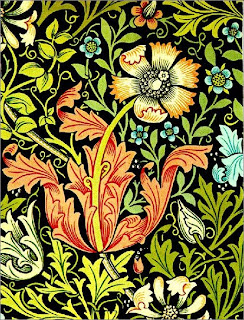In this post I would like to share work of William Morris.
I love patterns, and find William Morris the most extraordinary pattern designer ever. All his patterns are harmonious, and it explains their over a hundred years success.
The way he fills in space with floral elements and ornaments makes me look at the patterns over and over again. Learn more at a jump:
William Morris (24 March 1834 – 3 October 1896) was an English textile designer, artist, writer, and libertarian socialist. He founded a design firm in partnership with the artist Edward Burne-Jones, and the poet and artist Dante Gabriel Rossetti which profoundly influenced the decoration of churches and houses into the early 20th century. He was also a major contributor to reviving traditional textile arts and methods of production, and one of the founders of the Society for the Protection of Ancient Buildings, now a statutory element in the preservation of historic buildings in the UK
Morris tried his hand at architecture, oil painting, calligraphy, embroidery and wood-carving, as well as writing poetry. He eventually hit on his future career as a designer almost by accident. He and his university friend, the artist Edward Burne-Jones, moved into lodgings in London. Since they had no furniture Morris began designing his own. It was the beginning of a lifelong obsession with interior design.
Morris and a group of friends had started an interior decorating company, Morris, Marshall, Faulkner & Co, known as ‘The Firm’, in 1861. Determined to revolutionise standards of design, they produced furniture, textiles, tiles and glass as well as wallpaper.
Morris’s wallpapers were hand-printed from wooden blocks. He preferred traditional techniques. Hand-printing was time-consuming and expensive, but Morris thought the results far outshone the machine-printed wallpapers produced by many Victorian factories.
Morris is well known for taking inspiration from medieval European art, but perhaps less for his interest in historic textiles from the Middle East and the Indian sub-continent. This printed fabric shows that Morris also learnt from contemporary cottons imported from India, particularly in the strongly contrasting reds and blues, and the way the three-dimensional forms of flowers and leaves could be transformed into flat patterns.
Morris admired the fact that Indian cottons were hand-printed with natural, rather than chemical, dyes. In Britain knowledge of how to produce dyes from plants and vegetables was fast disappearing; most textile manufacturers found chemical dyes cheaper and easier to use. But Morris felt natural colours had a richness lacking in chemical dyes, and spent ten years working with a Staffordshire silk dyer named Thomas Wardle to revive their use.
Sources:
http://www.wmgallery.org.uk
http://en.wikipedia.org/wiki/William_Morris
I love patterns, and find William Morris the most extraordinary pattern designer ever. All his patterns are harmonious, and it explains their over a hundred years success.
The way he fills in space with floral elements and ornaments makes me look at the patterns over and over again. Learn more at a jump:
William Morris (24 March 1834 – 3 October 1896) was an English textile designer, artist, writer, and libertarian socialist. He founded a design firm in partnership with the artist Edward Burne-Jones, and the poet and artist Dante Gabriel Rossetti which profoundly influenced the decoration of churches and houses into the early 20th century. He was also a major contributor to reviving traditional textile arts and methods of production, and one of the founders of the Society for the Protection of Ancient Buildings, now a statutory element in the preservation of historic buildings in the UK
Morris tried his hand at architecture, oil painting, calligraphy, embroidery and wood-carving, as well as writing poetry. He eventually hit on his future career as a designer almost by accident. He and his university friend, the artist Edward Burne-Jones, moved into lodgings in London. Since they had no furniture Morris began designing his own. It was the beginning of a lifelong obsession with interior design.
Morris and a group of friends had started an interior decorating company, Morris, Marshall, Faulkner & Co, known as ‘The Firm’, in 1861. Determined to revolutionise standards of design, they produced furniture, textiles, tiles and glass as well as wallpaper.
Morris’s wallpapers were hand-printed from wooden blocks. He preferred traditional techniques. Hand-printing was time-consuming and expensive, but Morris thought the results far outshone the machine-printed wallpapers produced by many Victorian factories.
Morris is well known for taking inspiration from medieval European art, but perhaps less for his interest in historic textiles from the Middle East and the Indian sub-continent. This printed fabric shows that Morris also learnt from contemporary cottons imported from India, particularly in the strongly contrasting reds and blues, and the way the three-dimensional forms of flowers and leaves could be transformed into flat patterns.
Morris admired the fact that Indian cottons were hand-printed with natural, rather than chemical, dyes. In Britain knowledge of how to produce dyes from plants and vegetables was fast disappearing; most textile manufacturers found chemical dyes cheaper and easier to use. But Morris felt natural colours had a richness lacking in chemical dyes, and spent ten years working with a Staffordshire silk dyer named Thomas Wardle to revive their use.
http://www.wmgallery.org.uk
http://en.wikipedia.org/wiki/William_Morris










No comments:
Post a Comment